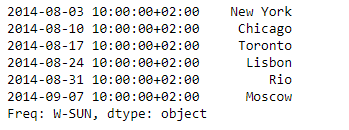Python | Pandas Series.to_csv()
Last Updated :
24 Jun, 2020
Pandas series is a One-dimensional ndarray with axis labels. The labels need not be unique but must be a hashable type. The object supports both integer- and label-based indexing and provides a host of methods for performing operations involving the index.
Pandas Series.to_csv() function write the given series object to a comma-separated values (csv) file/format.
Syntax: Series.to_csv(*args, **kwargs)
Parameter :
path_or_buf : File path or object, if None is provided the result is returned as a string.
sep : String of length 1. Field delimiter for the output file.
na_rep : Missing data representation.
float_format : Format string for floating point numbers.
columns : Columns to write
header : If a list of strings is given it is assumed to be aliases for the column names.
index : Write row names (index).
index_label : Column label for index column(s) if desired. If None is given, and header and index are True, then the index names are used.
mode : Python write mode, default ‘w’.
encoding : A string representing the encoding to use in the output file.
compression : Compression mode among the following possible values: {‘infer’, ‘gzip’, ‘bz2’, ‘zip’, ‘xz’, None}.
quoting : Defaults to csv.QUOTE_MINIMAL.
quotechar : String of length 1. Character used to quote fields.
Returns : None or str
Example #1: Use Series.to_csv() function to convert the given series object to csv format.
import pandas as pd
sr = pd.Series(['New York', 'Chicago', 'Toronto', 'Lisbon', 'Rio', 'Moscow'])
didx = pd.DatetimeIndex(start ='2014-08-01 10:00', freq ='W',
periods = 6, tz = 'Europe / Berlin')
sr.index = didx
print(sr)
|
Output :

Now we will use Series.to_csv() function to convert the given Series object into a comma separated format.
Output :

As we can see in the output, the Series.to_csv() function has converted the given Series object into a comma-separated format.
Example #2: Use Series.to_csv() function to convert the given series object to csv format.
import pandas as pd
sr = pd.Series([19.5, 16.8, None, 22.78, None, 20.124, None, 18.1002, None])
print(sr)
|
Output :

Now we will use Series.to_csv() function to convert the given Series object into a comma separated format.
Output :

As we can see in the output, the Series.to_csv() function has converted the given Series object into a comma-separated format.
Like Article
Suggest improvement
Share your thoughts in the comments
Please Login to comment...